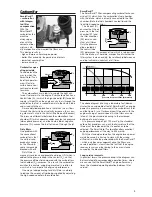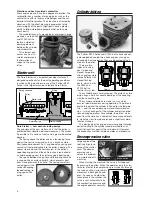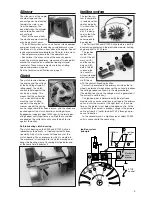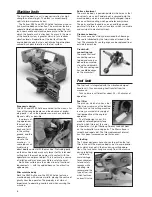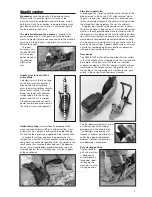
Carburettor
SmartCarb™
– carburettor
with integra-
ted filter
compensation
With the
SmartCarb™
carburettor, the
machine
always oper-
ates with the
correct air/fuel
mixture, virtu-
ally irrespective of how soiled the filters are.
This design results in:
- high and more uniform engine power
- better filter economy, longer service intervals
- lower fuel consumption
- lower emissions
Carburettor oper-
ating principle
To understand the
way in which the
SmartCarb™ car-
burettor operates,
we will first de-
scribe how a con-
ventional carburet-
tor works.
The carburettor’s main job is to supply the right mix-
ture of fuel and air to the engine. Every carburettor has a
Venturi tube (A), in which the high speed jet (B) for petrol
supply is fitted. When the engine sucks in air through the
carburettor, the fuel is sucked down into the Venturi tube
and mixed with the air.
A more detailed explanation is that
when the air flows
through the Venturi tube, air velocity increases, thus caus-
ing pressure to drop in the Venturi
(the Bernoulli theorem).
The pressure differential between the carburettor’s fuel
chamber (P
1
) which operates under constant air pressure
(atmospheric pressure), and the Venturi tube’s negative
pressure (P
2
), causes the fuel to flow out through the jet.
Dirty filters
One problem with
the conventional
carburettor is that
the air/fuel ratio
gradually changes
as the filters be-
come increasingly
blocked with dirt.
Dirty filters in-
crease air resistance and promote a drop at (P
3
) which is
added to the pressure drop in the venturi (P
2
), so that
the pressure differential compared with the carburettor’s
fuel chamber (P
1
) increases. As a result, the carburettor
enriches the mixture, supplying more fuel in relation to
air, which in turn impairs the engine’s performance.
One way of compensating for dirty filters is naturally
to reduce the amount of fuel being supplied by adjusting
the high-speed needle in the carburettor.
SmartCarb™
The SmartCarb™ filter-compensating carburettor has an
air duct (C) which links the carburettor’s fuel chamber
with the intake, which is directly connected to the filter
chamber. (Note the fuel chamber’s sealed lid and the
fixed high-speed nozzle.)
The air duct (C)
ensures that the air
pressure in the fuel
chamber (P1) and
the filter chamber
(P3) remains con-
stant at all times.
Only the pressure
drop created by
the venturi tube
(P2) determines the amount of fuel which is to be mixed
with the intake air. Therefore, irrespective of whether the
filter system is clean or dirty, the relationship between air
and fuel will remain constant at all times.
The above diagram (showing a laboratory test) demon-
strates the considerable effect of SmartCarb™ on engine
power. Air pressure is measured at the carburettor’s inlet
and the figure 0 is set for brand-new filters and with the
engine running at normal speed. As the filters accumu-
late dirt, the pressure drops owing to the increased
build-up of air resistance.
At a pressure drop of just 100 mm Vp, the standard
carburettor provides such a rich fuel/air mixture that the
filters must be replaced or the H-needle has to be
adjusted. The SmartCarb™ carburettor offers excellent
engine performance all the way to 500 mmVp.
With the standard carburettor, the engine loses power
mainly because it is having to work with the wrong
air/fuel ratio, while the power drop with the SmartCarb™
– which only becomes apparent once the filters are
severely polluted – stems from the fact that the engine
receives less air and fuel owing to the air resistance
caused by the blocked filters.
Long service intervals
In practical terms, the pressure drop in the diagram can
be translated into corresponding operation times, where
we can see that the SmartCarb™ engine offers many
times the standard operating duration between filter
service!
H-needle
P
1
P
3
P
2
C
P
1
P
3
P
2
60
80
100
0
100
200
300
400
500
Pressure drop over filter (mm water)
Power %
Intake air
H-needle
A
B
P
1
P
2
3



